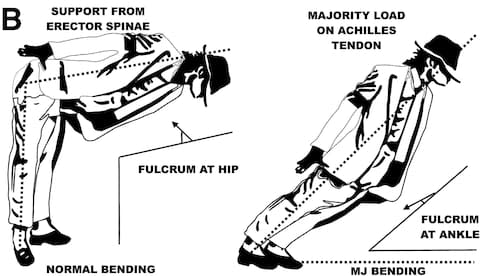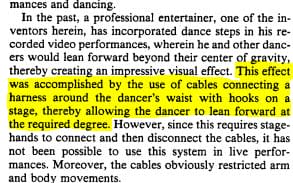The science of Smooth Criminal: Michael Jackson's gravity-defying dance moves explained

The King of Pop frequently baffled the world: how did he have such a powerful voice from such a young age? How did his appearance change so utterly? Why did he feel the need to dress his pet chimp in matching outfits?
But as much as his talent and his foibles fascinated the public, there was another aspect of Michael Jackson that has kept scientists and academics very busy: his legendary dance moves.
One of Jackson's signatures, the "anti-gravity lean", is so popular amongst wannabe dancers that Indian physicians have published a paper on the dangers of trying to emulate "MJ style" (as its known in India).
Jackson revealed the move in the 1988 video for Smooth Criminal. In a dimly-lit jazz club, Jackson and his suited backing dancers managed to lean at a 45° angle whilst keeping their bodies poker straight and their fedoras on.
Leaning over and remaining there sounds like a boring dance move, but its physical impossibility makes it mesmerising. How was it done?
In the Smooth Criminal video, Jackson just used wires to support himself in that impossible position, but he wanted to be able to perform the move live. Being hooked on and off a fishing line by stagehands would rather ruin the spectacle.
The wires were necessary because, as neurosurgeon Dr Nishant Yagnick explains, "it's not really possible physically to do it. He was cheating gravity."
Dr Yagnick and his colleagues Dr Tripathi and Dr Mohindra from the Postgraduate Institute of Medical Education and Research in Chandigarh, India, explore the phenomenon and its consequences in a Journal of Neurosurgery article called 'How did Michael Jackson challenge our understanding of spine biomechanics?'. When the human body bends from the waist, the erector spinae muscles in the back are able to support it. However, if you bend from the ankle rather than the spine, the strain is put on the calf and the Achilles tendon, which are not really suitable to the task.

"This allows for a very limited degree of forward bending from the ankle joints, while keeping a stiff straight posture -- unless you are Michael Jackson," the doctors explain in the study. "Most trained dancers with strong core strength will reach a maximum of 25 or 30 degrees of forward bending while performing this action."
Anyone who has ever rolled an ankle will be able to attest to how hard it is to support your weight on your ankle at an angle. Even as a trained dancer, MJ needed some help. In order to dispense with the wires, he got to work and developed a special shoe and stage set-up where the shoe would 'catch' at the right moment. Imagine retractable golf spikes, but coming up from the stage rather than down through the shoe.
Jackson patented the unique technology, but he needn't have worried too much about other people copying in it.
Yagnick said: "Normal people, even with the shoe, probably can't do it. It takes a lot of practice to develop the core muscles, abs and central trunk muscles to get the strength to do it."

He explained that the article in the Journal of Neurosurgery came about because "Particularly in India, where Michael Jackson is very popular, many people tried to copy him, and some even hurt themselves."
His colleague Tripathi believes that "whole generations of dancers" have been inspired by Jackson "to go beyond their limits": "So in India, neurosurgeons are perplexed due to all these new kinds of neuroskeletal injuries we are now seeing."
File the lean, then, under "don't try this" at home, even if you somehow have patented shoes.
Another dance move that is indelibly associated with Jackson, and that mystified audiences up its debut during a performance of Billie Jean at the 1983 Motown 25 television special was the moonwalk.
Unlike the lean, for which he invented unique apparatus, this move had a long history and was already part of the black street dance culture of popping and locking.
The moonwalk, or the backslide as it was known before Jackson rebranded it, had its nascence in mime: Marcel Marceau used it to great effect for his "walking against the wind" routine. Many other performers did something similar, including Fred Astaire and Sammy Davis Jnr. The move also has an unusual place in black history, as the first moonwalk committed on film was by black tap dancer Bill Bailey in Cabin in the Sky in 1943. This Lena Horne musical was pulled from many cinemas in the American South because of its black leads.

Fast-forward several decades, and Jeffrey Daniel was backsliding in episodes of Soul Train throughout the Seventies, and on Top of the Pops with Shalamar in 1982. Michael sought him out after he watched Daniel perform on a trip to Disneyland in 1980. Daniel mentored the younger dancer and taught him his signature trick.
The next year, of course, the rebranded Moonwalk went global, and dance-floors and playgrounds were full of amateur attempts to recreate the reversed gait. But how does it actually work?
The trick is to wear smooth-soled shoes (or just socks!) on a very smooth floor. As Rhett Allain, a professor of physics at Southeastern Louisiana University, asks, "The key here is: how do you make one foot slide and the other not slide?"
Allain wrote an article breaking down Jackson's movements into mathematical formulae, but in layman's terms it boils down to this realisation: "I could make the frictional forces on these two feet different by changing my center of mass."
The trick is to slide the leg that is in front of you backwards towards your other foot, whilst keep your weight on the ball of that back foot. In this way, you're creating friction which keeps your back foot steady, and provides the power for your front leg (the one that's sliding) to appear to glide frictionlessly across the floor.
As your gliding foot passes the heel of your other foot, lower your raised heel and go onto the ball of the other foot. Rinse and repeat.

It's a simple concept but anyone who has tried to do the moonwalk will know that it's harder than it looks. If anyone ever laughs at your attempts, point them to Rhett's diagrams and formulae and explain that the difficulty of the backslide is a scientific fact – unless perhaps you could invent shoes with soles that changed texture from extreme grip to silky smooth at the touch of a button.
The lean and the moonwalk aren't the only 'wow' moves that Jackson deployed. The showman loved to make a toaster-like entrance at his gigs by springing out from a trapdoor, and wowed audiences in Bucharest in 1993 when he literally flew around the stage with a 'rocket pack'.
Unlike the more rare and far more dangerous 'jetpack' which used jet engines, rocket packs use pressurised gases to create streams of superheated steam that thrust the wearer up into the air. This time, gravity really was defied. The only trickery was that it wasn't Michael Jackson who was wearing the rocket pack. Unlike the lean, this stunt was too dangerous, and the risk too bad. The rocket pack was worn by a stuntman.